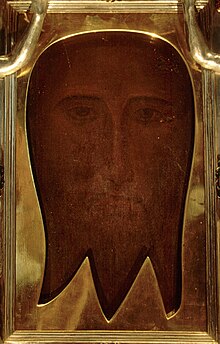Christ image

Images of Christ are representations of Christ through the visual arts .
According to Irenaeus , the earliest images of Christ were found among the Gnostics , who pretended to have them from Pilate based on the archetype. It was probably that of Emperor Severus Alexander in his house chapel next to Abraham, Orpheus and others. a. This kind of image of Christ was erected, as was the one mentioned in Eusebius 7:18.
Otherwise only the monogram of the name Christ and symbols such as the fish , which was drawn or written ( IXTHYS ) contained the first letters of the words Jesus Christ, Son of God, Savior .
Although Justin the Martyr and Tertullian imagined Christ ugly according to Isa 52,14 EU , Origen according to Ps 45 EU beautiful, initially it remained with the symbol, which then came scenes from the New and Old Testaments, in which Christ, in Roman form and attitude, teaching, healing the blind and those with gout disorders, awakening Lazarus , portrayed youthfully and without attempting to portray or was represented in Isaac, Moses, Jonas, Daniel. Paintings and sarcophagi of the catacombs often show "the good shepherd" in the costume of the time.
According to Augustine and Eusebius, there was still no specific type for Christ in the 4th century. Soon, however, the Apocryphal literature knows how to connect the correspondence between Christ and King Abgar at Edessa, also mentioned by Eusebius 1:14, with an image of Christ. Because later sources tell of a picture of Christ, the Mandylion , wonderfully pressed into a cloth , which is kept in Edessa, is said to have come to Constantinople in 944 and then to Rome.
Then John of Damascus describes the image of Christ in the 8th century, with which the account of Lentulus , which became known in the 11th century, and the Byzantine images of Christ harmonize. B. those in Ravenna and Rome, which depict Christ with a short, split beard, long hair parted in the middle and noble features. The images of Christ in the catacombs of Pontianus and Calixtus date from this time.
The type remains in the mosaics, on the emerald portrait that Pope Innocent VIII received from Constantinople, but which was not made before the 15th century, and in illuminated manuscripts until Giotto refined it in the 13th century, Fiesole deepened and Leonardo there Vinci completed in the Lord's Supper in Milan.
Since Giotto and the simultaneous sculpture on French portals, the artistic conception and the emphasis on human beauty have been decisive, so that the artists tried to embody an ideal of dignity, holiness and beauty in it; such as Michelangelo , Raphael and Titian .
The most important images of Christ in earlier painting are by van Eyck, Albrecht Dürer and the named, in the 19th century by Bertel Thorvaldsen , Peter von Cornelius , Heinrich Maria von Hess , Johann von Schraudolph and Schlotthauer .
Another series of images of Christ belong to the Veronica images , where the “face of pain” appears on the handkerchief. According to the legend, these were also created wonderfully and therefore form the other genus of Acheiropoieta (not created by human hands).
Orthodox Church
The Orthodox icons essentially have six types of the image of Christ:
- the not-man-made Redeemer, traced back to the Mandylion
- the almighty redeemer ( pantocrator )
- the Savior on the throne
- the Redeemer in the midst of the heavenly hosts
- the savior Immanuel (the twelve year old Jesus in the temple)
- the silent redeemer (Christ before the incarnation)
literature
- Giovanni Morello, Gerhard Wolf (ed.): Il volto di Cristo . Rome, Palazzo delle Esposizioni, December 9, 2000 - April 16, 2001. Electa, Milano 2000, ISBN 88-435-7682-8 .
- Gerhard Wolf: Archetypes of the face of Christ . In: Roland Krischel (Ed.): Views of Christ: Christ images from antiquity to the 20th century . Cologne, Wallraf-Richartz-Museum, Fondation Corboud, July 1 to October 2, 2005. DuMont, Cologne 2005, ISBN 3-8321-7565-2 , pp. 97-139.
- Anna Rosa Calderoni Masetti, Colette Dufour Bozzo, Gerhard Wolf (eds.): Intorno al Sacro Volto: Genova, Bisanzio e il Mediterraneo (secoli XI - XIV) . 1st edition. Marsilio, Venezia 2007, ISBN 88-317-9258-X . ( Collana del Art History Institute in Florence, Max Planck Institute . 11).
- Gerhard Wolf: veil and mirror. Traditions of the image of Christ and the image concepts of the Renaissance . 1st edition. Fink, Munich 2002, ISBN 3-7705-3632-0 .
- Wilhelm Grimm: The legend of the origin of the images of Christ (Treatises of the Berlin Academy 1842)
- Blissful: Christ Archeology . Prague 1862
- Wessely: Iconography of God and the Saints . Leipzig 1874
- Dietrichson: Christ picture set . Copenhagen 1880
- Hauck: The Origin of the Christ Type in Western Art . Heidelberg 1880
- Daniel Spanke: The Mandylion. Iconography, legends and image theory of the "images of Christ not made by human hands. (Monographs of the Icon Museum Recklinghausen, Vol. V) Recklinghausen 2000.
- Alex Stock : Face familiar and strange. New ways to Christ through images from the 19th and 20th centuries . Munich 1990, ISBN 3-466-36192-3 .
- Jaroslav Pelikan : Jesus Christ. Appearance and impact in 2000 years of cultural history. 1986, ISBN 3545250628
- Ralf van Bühren : Art and Church in the 20th Century. The reception of the Second Vatican Council. (Council History, Series B: Investigations) Ferdinand Schöningh, Paderborn 2008, ISBN 978-3-506-76388-4
- Eugen Drewermann : Jesus of Nazareth - images of a person ; Patmos Verlag, 2008, ISBN 3-491-21003-8 (10), ISBN 9783491210035 (13)
